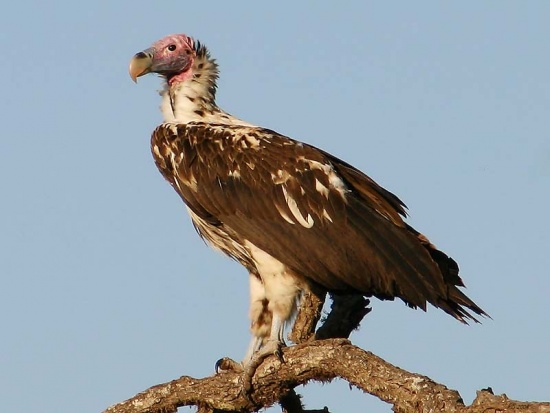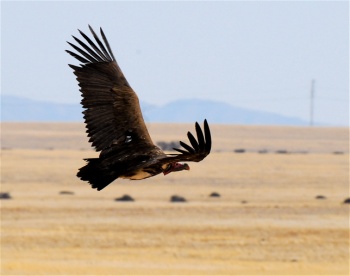(ID started. Incomplete gone.) |
|||
| Line 19: | Line 19: | ||
[[Ruppell's Vulture]] | [[Ruppell's Vulture]] | ||
==Distribution== | ==Distribution== | ||
| − | Widespread | + | Considered threatened (vulnerable). Widespread but scarce in sub-Saharan [[Africa]] from [[Senegal]] east to [[Ethiopia]] and north-west [[Somalia]] and south through the eastern half of the continent to the Cape but absent from the broad belt of Brachystegia woodland across [[Angola]], [[Zambia]] and [[Mozambique]]. |
Formerly more widespread in North Africa within the [[Western Palearctic]] and may still breed in northern [[Mauritania]], the Tibesti of northern [[Chad]] and in south-east [[Egypt]]. Now extinct as a wild bird in [[Israel]], where formerly bred in the Negev Desert but may still breed within the Western Palearctic in northern [[Saudi Arabia]]. | Formerly more widespread in North Africa within the [[Western Palearctic]] and may still breed in northern [[Mauritania]], the Tibesti of northern [[Chad]] and in south-east [[Egypt]]. Now extinct as a wild bird in [[Israel]], where formerly bred in the Negev Desert but may still breed within the Western Palearctic in northern [[Saudi Arabia]]. | ||
| Line 25: | Line 25: | ||
Adults are sedentary but young birds may wander widely. Small numbers are regularly seen in southern [[Egypt]] especially between Aswan and Abu Simbel and still occasionally recorded in Israel. Formerly more widespread as a breeding bird in North-West Africa but now largely a vagrant. Also recorded in [[Syria]], [[Jordan]] and in [[Libya]]. | Adults are sedentary but young birds may wander widely. Small numbers are regularly seen in southern [[Egypt]] especially between Aswan and Abu Simbel and still occasionally recorded in Israel. Formerly more widespread as a breeding bird in North-West Africa but now largely a vagrant. Also recorded in [[Syria]], [[Jordan]] and in [[Libya]]. | ||
| − | There is one 19th Century record from [[France]] and possibly also recorded in [[Spain]]. | + | There is one 19th Century record from [[France]] and possibly also recorded in [[Spain]]. |
| + | |||
==Taxonomy== | ==Taxonomy== | ||
====Subspecies<sup>[[#References|[1]]]</sup>==== | ====Subspecies<sup>[[#References|[1]]]</sup>==== | ||
Revision as of 23:41, 7 May 2010
- Torgos tracheliotus
Aegypius tracheliotus [2]
Identification
95–105 cm, wing-span 255–290 cm
- Bare pink head and neck - covered with obvious skin folds (lappets)
- Heavy bill
Adult
- Dark brown plumage
- Bbrown and white ruff
- White thighs
- Patches of white body down
- White bar on leading edge of underwing (African species) but may be less noticeable Middle Eastern birds
Juvenile
- Dark brown lappets
- Blackish flight feathers
Similar Species
Distribution
Considered threatened (vulnerable). Widespread but scarce in sub-Saharan Africa from Senegal east to Ethiopia and north-west Somalia and south through the eastern half of the continent to the Cape but absent from the broad belt of Brachystegia woodland across Angola, Zambia and Mozambique.
Formerly more widespread in North Africa within the Western Palearctic and may still breed in northern Mauritania, the Tibesti of northern Chad and in south-east Egypt. Now extinct as a wild bird in Israel, where formerly bred in the Negev Desert but may still breed within the Western Palearctic in northern Saudi Arabia.
Adults are sedentary but young birds may wander widely. Small numbers are regularly seen in southern Egypt especially between Aswan and Abu Simbel and still occasionally recorded in Israel. Formerly more widespread as a breeding bird in North-West Africa but now largely a vagrant. Also recorded in Syria, Jordan and in Libya.
There is one 19th Century record from France and possibly also recorded in Spain.
Taxonomy
Subspecies[1]
The species is usually regarded as monotypic but sometimes split into two-three races:
- T. t. tracheliotus:
- T. t. nubicus:
- T. t. negevensis:
- Southern Israel and Arabian Peninsula
Habitat
Arid steppes, deserts and mountain areas.
Behaviour
Flight
Majestic. Glides and soars on flat wings. When perched on tree, has a rather level posture with head up and held back between or above shoulders; when on ground, body more upright.Walks freely.
Breeding
Loosely colonial in some areas, solitary breeder in others, nest is built in the top of an acacia or on a cliff ledge.
References
- Clements, JF. 2008. The Clements Checklist of Birds of the World. 6th ed., with updates to December 2008. Ithaca: Cornell Univ. Press. ISBN 978-0801445019.
- Gill & Wright 2006
- BWPI
Recommended Citation
- BirdForum Opus contributors. (2024) Lappet-faced Vulture. In: BirdForum, the forum for wild birds and birding. Retrieved 16 June 2024 from https://www.birdforum.net/opus/Lappet-faced_Vulture





